New Chapter
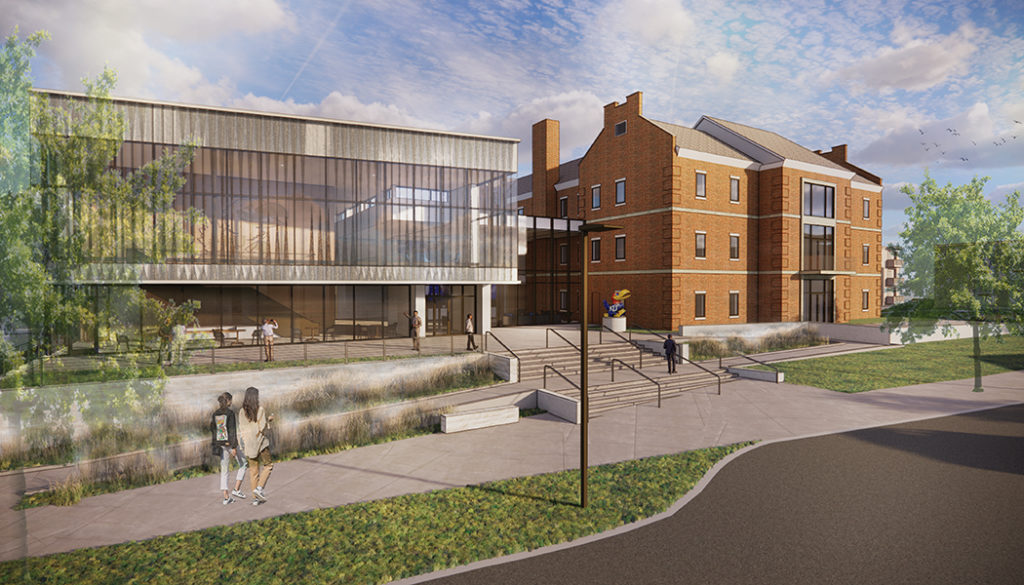
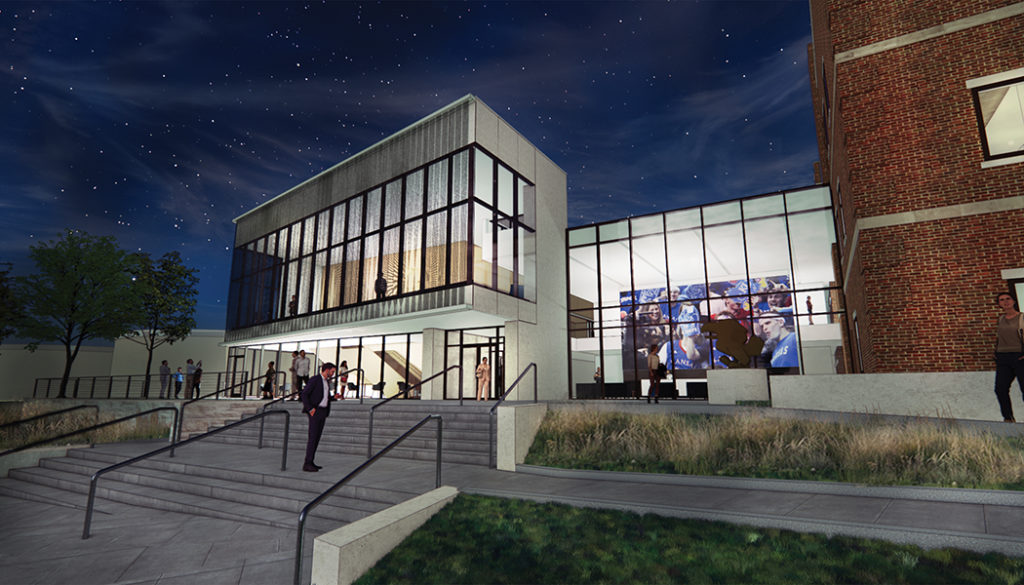
The room buzzed with energy and animated conversations, fueled by anticipation and semester’s-end anxiety, as second-year architecture students met their clients—alumni whose graduation years spanned five decades—on April 28, 2017, in the Adams Alumni Center. This was no time or place for small talk. With detailed drawings and intricate 3D models, the students presented their big ideas for a new structure that could one day connect to the Alumni Center and become the starting place for prospective students and their families to tour KU.
Gabrielle Foster, then a sophomore from Chicago, recalls those fateful conversations with her Jayhawk elders, members of the Alumni Association’s national Board of Directors.
“I remember the excitement in the room, both from the students who were ready to present and from the alumni who had come back,” says Foster, g’20. “We were seeing the future of KU and the encompassing idea of past, present and future all in one building. As we explained our ideas and walked them through our plans, their eyes were glowing.”
Former board member Jerry Skillett, b’81, marveled at the “brilliant” students, who took the assignment to heart. “I actually had tears in my eyes because I couldn’t believe how committed they were to the vision,” he recalls. “This is where you start, and this is you’re mentored, and this is where you finish—this whole 360-degree view of your life at the University all in one place. They were really trying to create that story.”
After the presentations, when the board members resumed their meeting, Skillett was among the first to speak. “We saw through the students’ eyes what would attract them to KU,” he said.
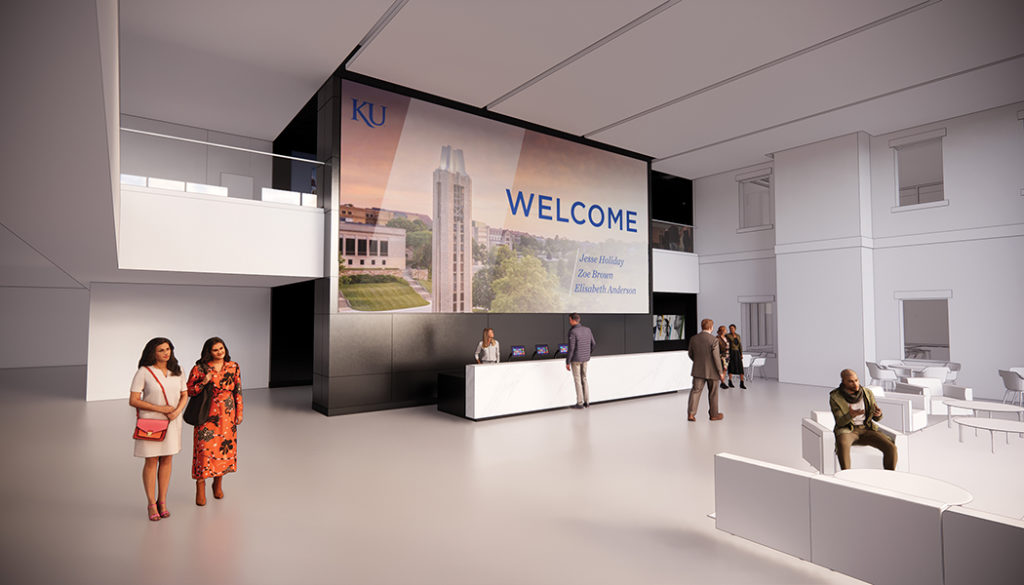
The notion of a new welcome center, atop Mount Oread at the entrance to historic Jayhawk Boulevard, had first surfaced two years earlier, in summer 2015, in a casual “what if ?” email between KU colleagues. Matt Melvin, vice provost for enrollment management, posed the question. Heath Peterson, then interim president of the Alumni Association, suggested lunch. Weeks later, when they walked back from lunch at The Oread hotel, they stopped in front of the parking garage and gazed across the street at the Adams Alumni Center. “The more we talked, the more compelling this project became in terms of how we could really position the University to win the campus visit through a storytelling experience,” says Peterson, d’04, g’09, who became the Association’s president in November 2015. “We thought how great it would be if we could bring to life this symbolic idea of marrying the past to the future.”
Melvin, who arrived in Lawrence in 2010 to lead a transformation of student recruitment, worked with the KU Admissions team, campus leaders and alumni to revamp scholarships, recruiting strategies, data analysis and other aspects of attracting new Jayhawks, especially in an era of declining populations of high school graduates. Next on his wish list was a better launching point for campus visits, which since 1999 have most often started at the KU Visitor Center, the remodeled first floor of Templin Hall, near 15th Street.
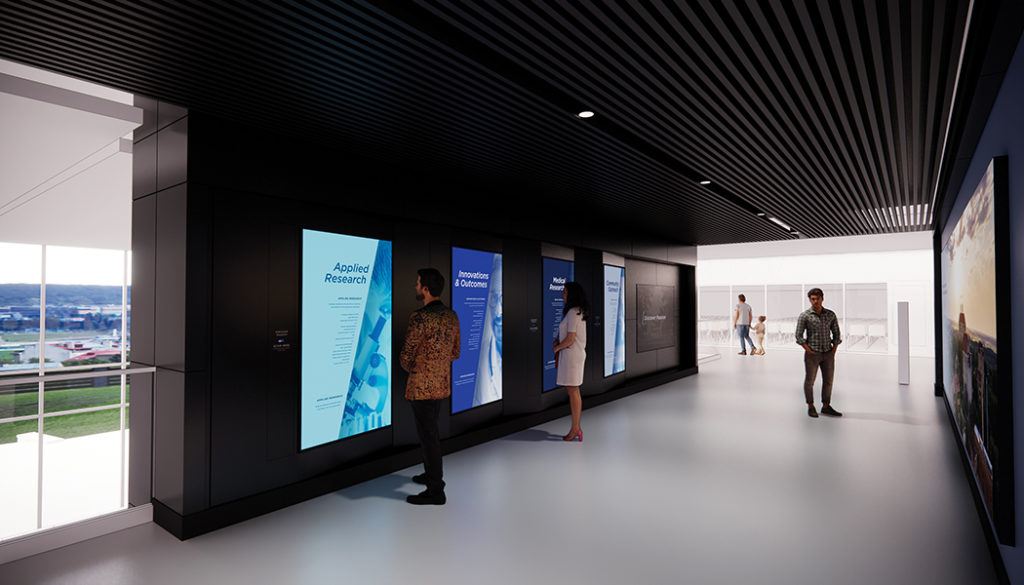
“The campus visit will always be the most important strategy and factor in students’ decision process,” Melvin says. “Our campus visit is good, but we want it to shine.”
The location, limited space and outdated technology in the current Visitor Center prevent KU from showcasing what Melvin calls “the arc of the Jayhawk experience,” including campus life, stories of Jayhawk career successes, research and innovation, history and traditions, and KU’s global reach. “One of the sustainable competitive advantages of KU is the alumni network,” he says, “We want to be very intentional and purposeful with communicating to students and their families the value add—the power—of that network.”
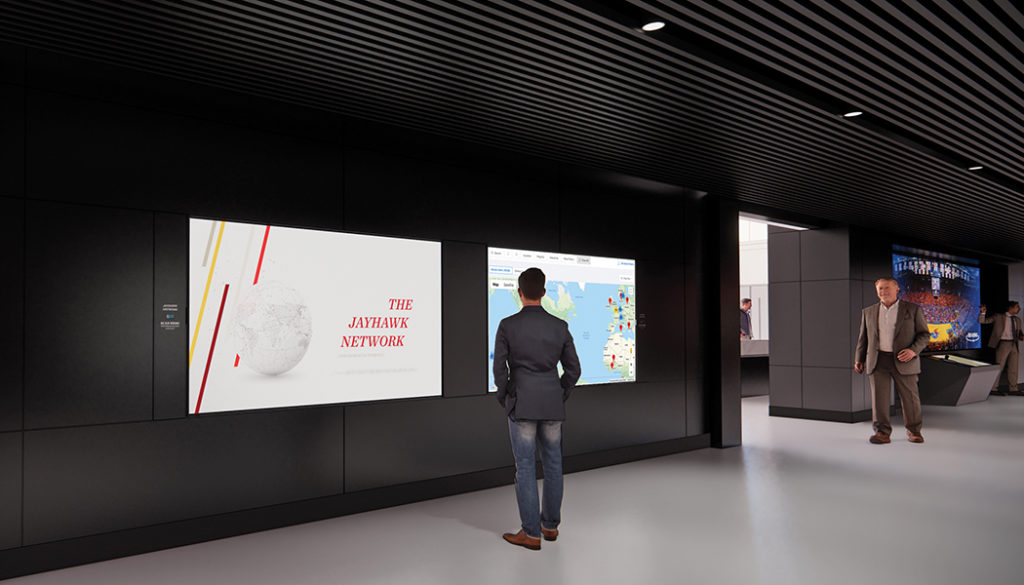
In the six years since Melvin and Peterson first imagined a new place for future and current Jayhawks, momentum for what became known as the Jayhawk Welcome Center has grown. Chancellor Doug Girod, who in 2017 succeeded Bernadette Gray-Little as KU’s leader, added his strong endorsement of the project to the green light she had signaled. The need has only increased in an era of intense competition for new students, and recent enrollment results affirmed the pivotal power of the campus visit. In 2019 and 2020, prospective students who visited KU enrolled at twice the rate of those who did not visit.
Girod calls the Jayhawk Welcome Center “a real game-changer” for KU’s future: “Across the nation, we are seeing fewer high school graduates, and that trend will continue for the next decade. That puts a lot of pressure on enrollment, which is why the Jayhawk Welcome Center is so important to our University and our mission.”
Since the Adams Alumni Center opened in 1983, the alumni population has grown by more than 40% and the Alumni Association has transformed its programs and services for Jayhawks.
“If you really inventory the challenges facing higher ed today—the state’s general disinvestment, increasing tuition—you see families wanting to see a return on the investment they make,” Peterson says. “How are we helping students make career connections? What kind of resources can we provide to enhance the student experience? The Alumni Association is uniquely positioned to drive that value.”
To expand its services and impact, the Association, in partnership with KU Endowment, invested in the Student Alumni Network. Since 2017, the organization has grown from 1,200 members to 6,000, becoming the largest student group on campus and the largest of its kind in the Big 12. The Jayhawk Career Network, launched in 2018 with gifts from alumni donors, connects students with successful alumni worldwide for mentorship and career resources; more than 8,000 alumni and students currently participate in mentoring.
Encouraged by donor support for expanding both student and career programs—and mindful of the need to boost student recruitment by creating an unrivaled campus visit—KU Endowment and the Alumni Association began to seek contributions to fund the new Jayhawk Welcome Center and renovated Adams Alumni Center.
Donors endorsed the project’s purpose and location, according to Dale Seuferling, j’77, KU Endowment president. “Donors understand that this is a critical time in the life of the University and KU must be competitive in recruiting the next generation of Jayhawks. The time has arrived for KU to up its game,” he says. “As alumni reflect on their first impressions of KU, they immediately embrace the concept of a Welcome Center on Jayhawk Boulevard. That’s the right location.”
Thus far donors have committed $21 million for the 30,000-square-foot expansion. The Association and KU Endowment continue to seek gifts to fund $8 million in remaining renovation costs, including $3 million to support new technology and $5 million to modernize the Adams Center and connect the existing structure to the new Welcome Center’s event spaces.
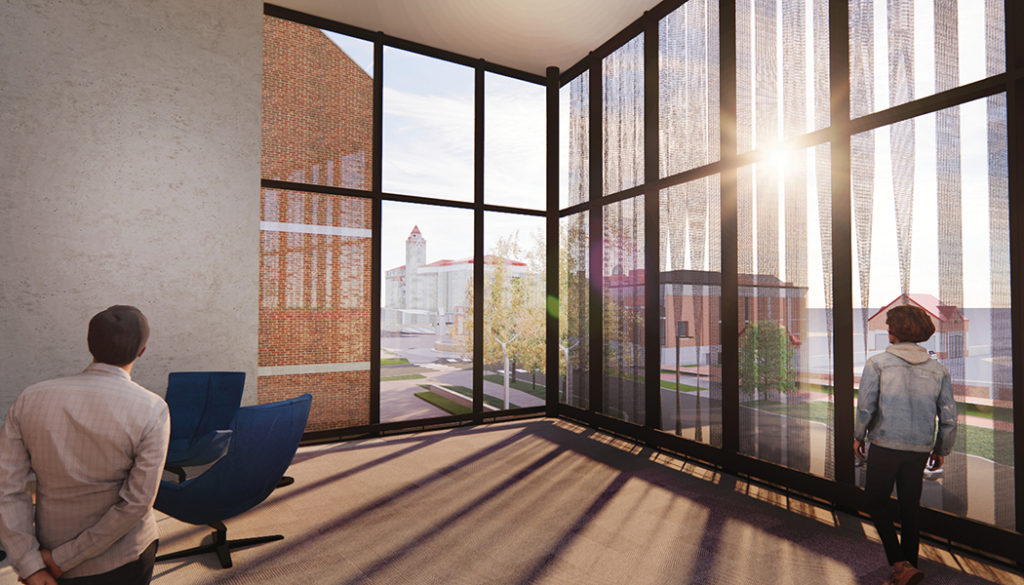
As designs for the project began to take shape, KU architecture students continued to offer their ideas. Following the spring 2017 studio course, associate professors Marie Alice L’Heureux and Kapila Silva each spring have challenged their second-year students to explore designs for the project.
Peterson says the ongoing student involvement was critical to the design process. “We spent an incredible amount of time on the design, and we engaged many stakeholders—campus leaders, our national board of directors, our team. We wanted to protect the past, the history and the elegance of the Adams Center while also positioning the project to resonate with the next generation,” he says. “We felt like the most effective way to do that was not for all of us to be sitting in a room talking about what we think students want, but to actually engage students in the process. Ultimately that led to a more contemporary design. What we heard loud and clear was that students want the views and the beauty of the Hill, the natural light, more modern space that isn’t quite as closed off.”
To create the final design, project leaders from the University, the Alumni Association and KU Endowment turned to Helix Architecture + Design, a Kansas City firm led by founders Reeves Wiedeman, a’79, a’82, and Jay Tomlinson, a’82, a’82. Helix also designed the KU Medical Center’s Health Education Building, which opened in 2017 on the Kansas City campus.
Wiedeman says the Helix team was invigorated by multiple challenges—to create a dynamic first impression, integrate the design with the traditional architecture of the Adams Alumni Center and highlight the spectacular campus views. “We wanted people to feel like they were actually connected to the campus,” he says, “so you can actually feel and see the Hill, the Boulevard, the sunset.”
But western sun pouring through walls of glass presented another challenge, especially for a firm that prides itself on creating energy-efficient designs. Helix found the solution in solar screens, which provide “an attractive, artistic approach … but are also very functional,” Wiedeman explains. “They calm that warm sun down and filter the light into the building, reducing heat gain and therefore reducing energy costs.”
Sustainability and innovation also guided another project partner, Black & Veatch. The global engineering, construction and consulting firm based in Kansas City will provide solar panels atop the Welcome Center, along with battery storage and a display board to track energy collection for the new structure.
Clint Robinson, e’85, g’91, Black & Veatch associate vice president, says the features will “stimulate kids and parents to thinking about the future” and symbolize the firm’s collaboration with KU through the past century and into the next. Founded in 1915 by Jayhawks E.B. Black, e1906, g’24, and N. T. Veatch Jr., e1909, g’24, Black & Veatch has hired countless Jayhawks in engineering and many other fields through the years. Both founders led the Alumni Association as national chairs, as did more recent CEOs of the firm, P.J. “Jim” Adam, e’56, and Jack Robinson, e’49, Clint Robinson’s father.
In fact, the Robinson family traces its KU lineage back to Clint’s great-grandfather, David H. Robinson, one of three professors (with Elial Rice and Francis Snow) who welcomed the first KU students to Old North College on the first day of classes, Sept. 12, 1866.
“Nearly 156 years later, we’re still talking about welcoming students to the University of Kansas,” Clint says. “I’m proud of that my family and the company that I represent, Black & Veatch, are part of that welcoming process.”
“When they say, ‘Meet me on campus,’ this will be the spot.
To build the Jayhawk Welcome Center, renovate the Adams Alumni Center and bridge the modern and traditional structures, project leaders selected McCownGordon, another Kansas City company that includes many Jayhawks. McCownGordon has constructed notable KU projects, including the Integrated Science Building, focal point of the Central District on the Lawrence campus, and the nearby Horejsi Family Volleyball Arena, home of the KU volleyball team.
On the other side of campus, the company also renovated a treasured symbol of the past: Corbin Hall, KU first residence hall, a stone’s throw from the site of Old North College.
Matt Glenn, McCown Gordon project executive, says the Jayhawk Welcome Center’s modern exterior will honor Kansas tradition. “One of the iconic features of the building is going to be on the west façade, these twisted, stainless-steel metal fins that go up the building,” Glenn says. “They’re going to be replicating the waving wheat that is always going to make the building memorable as your gateway into the campus.”
Stories of KU’s past and present, including notable traditions and Jayhawk successes, will greet visitors to the Jayhawk Welcome Center and renovated Adams Alumni Center in digital experiences and exhibits created by Dimensional Innovations of Kansas City. For KU, the firm has created exhibits in Allen Field House, the Booth Family Hall of Athletics and Capitol Federal Hall, home of the School of Business.
Dimensional Innovations is known for designing interactive experiences that visitors can customize based on their own preferences. In the Jayhawk Welcome Center, prospective students’ information and interests will translate into individual QR codes, which students can scan to select relevant stories, explains Tucker Trotter, f ’97, the firm’s CEO. “If we do it right, which we will, you will want the people to choose the stories that matter most to them. Everybody is different and everybody has a different interest,” he says. “They have to be able to see themselves here … then drill down if they’re interested and learn more about what that might look like.”
The stories of individual Jayhawks, including alumni mentors, will send a powerful message about the KU network. “We can help people understand not just how amazing this place is, but how amazing the alumni are,” Trotter says, “and how supportive they are of each other and of students and how much they are willing to do things to help them get ahead. It’s a really unique characteristic of Jayhawks.”

In spring 2020, just before she graduated, Gabrielle Foster and her architecture classmates met with that semester’s second-year studio class to review their designs, offer critiques and share ideas. The future architects also met the professionals from Helix, who presented their designs. Foster laughs as she recalls comparing her work for an assignment three years earlier with the drawings that will guide the real project. “Well, they definitely designed it better, more realistically, than my second-year studio brain could have done,” she says.
But she also noted the similarities: “I was just nodding my head during their presentation because there were key points we had touched on—incorporating the past, present and future and KU traditions, and the sight lines to campus that were the defining feature.”
Wiedeman says the students’ ideas made an impact on the decision-makers, who saw that “this was an opportunity to say something about KU, to be forward-thinking, to be progressive,” he says. “When the students presented their ideas to the Alumni Association board, I think it opened up a lot of eyes and people said, ‘Wow, this isn’t just another building. There is an excellent opportunity to do something special, something that just resonates on so many levels.’ Those students had a big impact on the confidence to go forward with a project like this.”
Former Association board member Jerry Skillett agrees. “They changed the way we looked at the whole project, not just from a visual basis but just how important it really was,” he says. “They brought to life the Alumni Center as something for everyone to participate in, not just when you’re 60 years old. It was just amazing.”
Foster says her discussions with alumni in April 2017 sparked her confidence, spurring her to become a student ambassador for KU Admissions and a leader in the Student Alumni Network. “Interacting with alumni made me more comfortable in reaching out to them later in my career at KU, to land an internship in Kansas City and put on events for students and alumni, where we could ask their advice about their experiences.”
Skillett, who with his wife, Leonor, assoc., often mentors students, says, “This younger generation really does seek out mentors and advice. There’s a lack of fear of having those discussions. Maybe our generation was out to prove ourselves and the last thing we wanted to do was talk to someone older.”
Leonor says the Jayhawk Welcome Center as a student project “gave those students an opportunity to create a legacy, to have foresight into the future, and that’s honorable. We normally don’t think about our legacy until we’re older. That experience opened doors for them.”
Wiedeman harks back to his years on the Hill when he describes the project as “the highlight of my career, no question about it. Being an architecture student, you’re trained for a building like this. This is what we’re here for—important buildings, legacy buildings, such as this one is going to be, a building that will become the spot for the University. … I think this will be the meeting place for future, for all Jayhawks.
“When they say, ‘Meet me on campus,’ this will be the spot.”
For more information on the Jayhawk Welcome Center, including construction progress, building features and donor support, visit jayhawkwelcomecenter.org.